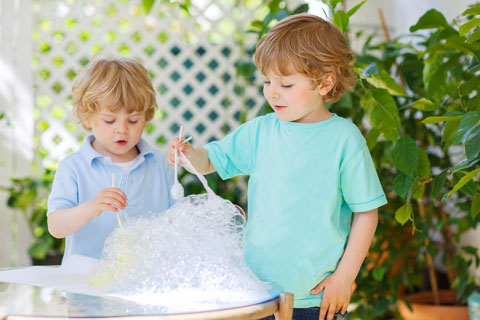Cooperation means doing things together to reach a common goal. Each person’s needs are respected, and each person contributes to the group’s success in reaching its goal. Illinois Early Learning and Development benchmarks for social-emotional development stress several keys to cooperation that are also important in science: curiosity, communication, problem solving, and creativity.

How can you find topics for cooperative scientific study for use with preschoolers?
Begin by watching them interact with their environment. For example, most preschoolers have used various kinds of balls in their play. You might bring children together for a collaborative, in-depth investigation of balls.
Start by inviting children to brainstorm.
“What are some things you know about balls?” Record ideas on a flip chart or chalkboard. (Note: Do not correct mistaken ideas at this time!) Follow up with, “What would you like to find out about balls?” Children who are interested in the same research questions can collect their data in small groups.
Help the research groups plan by asking.
“How will you look for answers to your questions? What will you need for your research? Who will do which jobs?” Each group can create a folder for its research plan and data.
Assist children in meeting the challenges of working with partners.
When they disagree about what to do or what they have found, urge them to ask for other classmates’ views and suggestions during a whole group meeting. Or suggest that they let a problem rest until members are calmer.
Help children practice turn taking when they record data or use scientific tools.
“I’ll measure how far the ball rolls with my yardstick, and Joe can tally marks on our chart.”
Have research teams report findings, questions, and problems during group meetings.
Expressing thoughts and listening to others’ ideas are important parts of cooperation. Encourage children to respond to each other: “Any comments or questions for the ‘bounce study group’?” “Eun-ju suggested one way to measure the soccer ball. Does that help you?”
Invite children to revisit their early ideas about the topic.
“You thought that all balls were bouncy. Have all the balls you studied bounced?”
When a child asks you for help, you might direct him to a peer expert.
“You could ask Kate to show you how she dribbles a ball.”
When teams finish their studies, help them decide how to represent and share what they found out.
“Jaime wants to bake a football-shaped cake to share with parents. Latasha suggests that we make a book of drawings of each ball you studied.” Watch to see if the groups need guidance as they work on their representations.


 Printer-friendly PDF
Printer-friendly PDF PDF para imprimir
PDF para imprimir